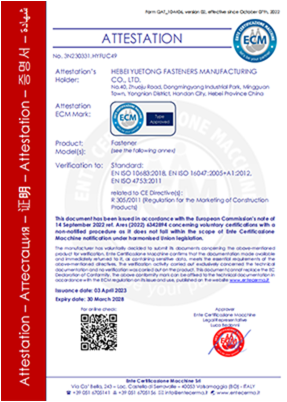अगस्त . 01, 2024 05:01 Back to list
Exploring Various Bolt Types Alongside Images for Better Understanding and Identification
Different Types of Bolts with Pictures
Bolts are integral components used in fastening applications across various industries, including construction, automotive, and manufacturing. Understanding the different types of bolts available, along with their unique characteristics, can aid in selecting the right one for specific tasks. This article will explore several common types of bolts, providing descriptions and insights into their typical uses.
1. Hex Head Bolt
The hex head bolt is perhaps the most commonly recognized type of bolt. Its hexagonal head allows for easy gripping with a wrench, making it ideal for heavy-duty applications. These bolts are often made from steel and are used extensively in construction, machinery, and automotive industries. The threads of a hex head bolt can be fully or partially threaded, depending on the application.

2. Carriage Bolt
Carriage bolts feature a rounded head that is smooth on top, making them perfect for applications where the bolt head is visible and appearance matters. They typically have a square neck that prevents the bolt from turning when the nut is being tightened. Carriage bolts are commonly used in wood and metal connections, like securing wooden beams together or in furniture assembly.
3. Lag Bolt
Lag bolts, or lag screws, are designed for heavy-duty applications where strong joining is required, particularly in wood. They have a thick shank and are often used in construction projects for fastening large wooden structures. The large diameter and coarse threads help them grip the wood securely, making them ideal for decks and heavy furniture.

different types of bolts with pictures

4. Socket Head Cap Bolt
Socket head cap bolts are known for their cylindrical head and hex socket drive. They provide a high level of torque and are typically used in machine applications where space restrictions apply. Their design allows for tightening with an Allen wrench, making them a popular choice in the manufacturing and assembly of machinery.

5. Eye Bolt
Eye bolts have a looped head that resembles an eye, allowing for the attachment of cables or ropes. They are typically used for lifting and securing loads, making them essential in construction and rigging. Eye bolts come in different shapes, including screw eye bolts and round eye bolts, each designed for specific applications.

6. Jam Nut
A jam nut, also known as a lock nut, is a thin nut used in conjunction with a thicker nut to prevent loosening due to vibration. When tightened against another nut, it creates a locking mechanism that keeps the assembly secure. Jam nuts are useful in mechanical assemblies and automotive applications to ensure consistent performance under dynamic conditions.

Conclusion
The selection of the appropriate type of bolt is crucial for the success and safety of any project. Factors such as the materials being joined, the required strength, and environmental conditions all play a role in the decision-making process. Understanding the characteristics of different bolts, from hex head bolts to eye bolts, helps ensure that the right fastening solution is employed, contributing to the longevity and integrity of the assembly. Whether in construction, automotive, or everyday applications, the right bolt can make all the difference.
-
The Ubiquitous Reach of DIN934 in Application Realms
NewsMay.16,2025
-
Exploring Different Bolt Types
NewsMay.16,2025
-
Cracking the Code of Sleeve Anchor Mastery
NewsMay.16,2025
-
Clamp Design Principles,Types and Innovations
NewsMay.16,2025
-
Artistry Inspired by the Humble Anchor Bolt
NewsMay.16,2025
-
A Deep Dive into Screw Types
NewsMay.16,2025


